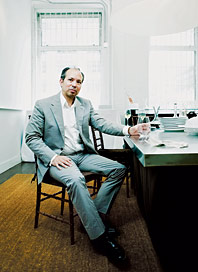
Olivier Cheng
What should a couple know before booking their caterer?
What their vision is. Is it seated? Interactive? Also, find out what the caterer provides as far as staffing, and make sure the cost of rentals is included in the fee. Some caterers lowball the proposal to get the job, and then, once booked, tack on X, Y, and Z additional fees. A lot of couples say I’m too expensive at $300 plus, but then I hear that at the end of the day, they wound up paying the same with all those extra fees.
The cocktail hour is a favorite, food-wise. What are your best appetizers?
I like doing something prosaic like a grilled-cheese sandwich but using Italian truffled cheese and adding a little celery relish on top. I like lobster rolls, seared lamb with mint chutney on a rosemary skewer, or Wagyu beef on a chopstick skewer. And pigs in a blanket! I used to hate them. I used to think they symbolized bad catering. But there’s something about evoking childhood memories that makes people feel comfortable. A selection of eight hors d’oeuvre is good, and each should be no larger than a bite and a half.
What’s a great idea for a food station during cocktails?
In the summer, a seviche bar made of ice. Literally, we carve out containers inside four-foot-long blocks of ice, put a Lucite or glass liner inside so that the melting ice does not interact with the food, and either underlight or top-light it to provide a nice textural moment.
How have you tailored a couple’s menu to reflect their heritage?
For a Korean bride and Polish groom, we did potato-pancake-and-salmon hors d’oeuvre that recalled a dish his grandmother used to make, and a miso-glazed black cod with Korean cucumber salad as a first course. There was a woman who came to us wanting harissa done the way her grandmother made it in Morocco. She brought us a bottle of it, and we tasted it and went flavor to flavor, replicating exactly what was in that jar without a recipe.
What’s an innovative first course?
Serving a three-layered tasting plate. It gives guests something to talk about.
What are some trios you’d suggest?
A tasting of three chilled vegetable soups: minted sweet pea, asparagus thyme, cucumber coconut. You can do beet tartare, beet napoleon with goat cheese, and a chilled beet-and-buttermilk soup. A trio of seviches—Montauk tuna with coconut and mint, black bass with mango and jicama, and shrimp with avocado.
How do you make chicken exciting?
Serve baby chicken, or poussin, and serve the whole bird. It’s a much more upscale version of chicken and feels like a delicacy served this way. I would do a grilled butterflied poussin with ragoût of corn, favas, chanterelles, and smoked bacon.
How can you dress up the other familiar standby, salmon?
Stay away from soy glaze or teriyaki, which sounds very generic. Using seasonal ingredients for sides makes it feel more thought-out and less cookie-cutter. The right presentation can make a dish feel more special: Layer the dish so the salmon is the top layer, and the other ingredients are underneath the salmon, and the sauce becomes more of an element on the plate. And make sure you get king salmon, which is not farm raised. It looks and tastes better. It’s pricier but well worth it.

TIPS FROM THE TRADE
The after-party is the perfect opportunity for a catering encore. After so many cocktails and calorie-burning dance-offs, guests are hungry again. Satiate drunken appetites with miniature greasy appetizers: burgers with fries in paper cups, or crêpes and bacon-and-egg-filled English muffins during the wee hours (Cheng charges $15 per person). “Count on a third of your guests coming,” he says. “And don’t have it where you had your reception. The staff will be forced to wait to clean up, and that will drive up your overall cost.”
212-625-3151; ocnyc.com